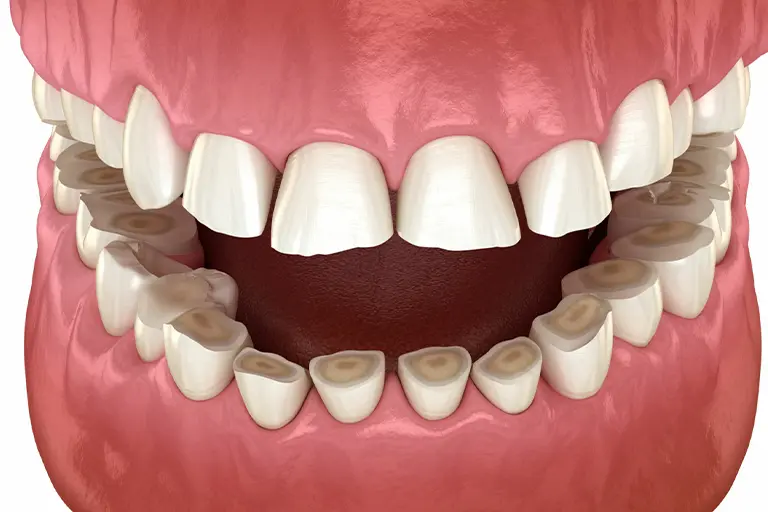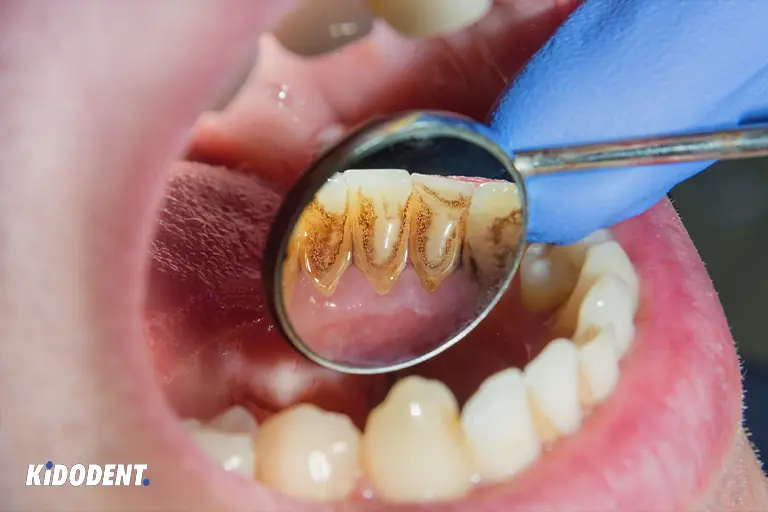What is dental erosion?
Dental erosion, known as enamel erosion, is the loss of enamel structure on teeth because of acids. Erosion of teeth is the result of chemical action involving acids and not a bacterial cause as in tooth decay. Dental erosion happens due to excess acids in foods and drinks or repeated exposure to stomach acids.
The enamel is the outer layer of teeth and protects the dentin, the inner layer. When acids attack the enamel, little by little the enamel structure on your teeth dissolves and is lost. If enamel wears away, tooth sensitivity is one common sign that you may experience.
How to know if you have dental erosion?
There are some common signs and symptoms that help you detect dental erosion. Your teeth have lost the mineral structure and the remaining enamel on teeth appear shiny. Since the dentin is yellower in color, you can see that the underlying grooves and surface on the tooth appear yellow. Sometimes due to too much enamel loss, you can see the pink color on the tooth.
The most important signs and symptoms of dental erosion are:
- Polished and shiny remaining enamel on teeth
- Yellow color on teeth, which is a sign of exposed dentin and not a cavity or tooth decay
- Sensitivity and pain in teeth, which is caused by acid contact on teeth or even damage to your pulp that requires a root canal
- Rough or cupped shaped teeth. Your teeth have lost its form and rough edges on the corners of teeth look sharp (as in front teeth) or the occlusal surfaces is flattened with yellow groves inside similar to cups (as in back teeth).
- The preservation of enamel similar to a white line on the gum line and appearance of chipped or reduced surface just next. This common symptom of dental erosion is known as preservation of enamel on the gingival crevice.
- Raised restoration. Your dental filling such as amalgam or other filling materials on teeth appear elevated and prominent compared to the surrounding structure, which is dissolved and worn away.

Dental erosion causes
There are several factors that either contribute to or directly cause tooth enamel to erode. We explain the common causes as follows:
- High consumption of acid drinks and foods:
-
if you have high intake of acid, or dietary sources rich in acid, dental erosion is most likely ruin your teeth and is undeniable. Repeated use of energy drinks, soft drinks (e.g., soda), wine, fruit juice, vinegar and caffeine-containing beverages are common drinks that cause enamel erosion.
Citrus fruits such as oranges, limes and lemons are common fruits that destroy the enamel if consumed in large amount and especially with direct teeth contact. Chewing on vitamin tablets like vitamin C tablets or sugar-containing or fruit-flavored candies is also a damaging cause for tooth tissues.
- Gastroesophageal Reflux Disease (GERD):
-
GERD is the reflux of acid from stomach back to the esophagus or even into your mouth. In this digestive disorder, the constant flow back of acid causes you feeling of pain and burn in your chest, known as heartburn. The acid refluxed back in your mouth pools behind the teeth on the palatal and posterior (back) surface of your front teeth. Therefore, dental erosion occurs.
Vomiting is also directly related to certain gastrointestinal disorders, which erodes enamel on teeth. During the early weeks of pregnancy, vomiting is common. This pregnancy-induced vomiting will impact the dental health since the stomach acid is thrown up and directly have contacts on teeth, causing erosion.
The recurrent vomiting and acid-containing contents from your stomach will lead to glassy darkened and yellowish surface on the back surface of your teeth, which is a sign of enamel erosion.
- Saliva disorders:
-
saliva is responsible for washing away food particles, fighting against acids in your mouth and having numerous other benefits. One of the most important saliva’s functions is remineralization of teeth.
Saliva remineralizes the enamel on your teeth by bathing the teeth in saliva fluid or let’s say calcium containing fluid in your saliva.
When there is low amount of saliva due to xerostomia (dry mouth), medications, aging, syndromes and diseases, your mouth can’t tolerate the high acidity, so tooth enamel is damaged and dental erosion occurs. - Eating disorders:
-
certain gastrointestinal diseases and conditions can cause sever forms of eating disorders. Bulimia and anorexia nervosa are two common eating disorders. People with these eating problems experience uncontrolled episodes of eating large amounts of foods, which is called bingeing. They may also have purging episodes, which they do self-induced vomiting or using laxatives to empty their stomach.
These recurrent damaging activities in eating and vomiting cause dental erosion and make the enamel susceptible with too much stomach acid contact on teeth. Individuals with bulimia and anorexia have fears of gaining weight and do not perceive their body image correctly. Bulimia and anorexia have psychiatric origins, which cause serious health risks.
Enamel is one of the hardest tissues in human teeth. When erosion on teeth cause enamel damage, it is irreversible. Nothing can bring back your lost enamel, so you need to try preventive strategies or have your damaged teeth fixed with dental restoration or opt for other dental treatments
How to prevent dental erosion?
Enamel erosion happens overtime and prevention is necessary to stop the erosion or slow down its progress. An early diagnosis by your dentist can prevent longtime affects. You can also:
- Cut down on foods and drinks rich in acids.
- Use fewer soft drinks, juice and other drinks that contain too much acid. Not only do the acids cause tooth erosion but also the sugar in these drinks and foods is responsible for cavities and decay of your teeth. If consumed, do not swish these beverages in your mouth to decrease longer contact with teeth.
- Drink more water.
- If you are doing sports or have hard physical activity, use water to stay hydrated and avoid drinking energy drinks. You don’t need to quench your thirst with soda every time you feel thirsty.
- Brush with a fluoride toothpaste.
- Fluoride helps mineralization of enamel. It is a crucial ingredient that you must look for when you choose your toothpaste or select other oral health products such as mouthwashes.
- Proper brushing habit.
- You should not only brush at the right time but brush gently. Avoid immediately brushing your teeth after eating or drinking acidic foods. Wait for 30 minutes or an hour. Also, aggressive brushing or using abrasive toothbrushes weakens the enamels structure on your teeth.
- Have a healthy choice of diet.
- Eating healthy foods and avoiding processed foods can help the prevention of dental erosion. Regularly have dairy products and consider a diet rich in minerals. By eating at right time and healthy portions, you can prevent heartburn and acid reflux that causes dental erosion.
- Chew xylitol-containing gum.
- You can chew sugar-free gums like xylitol products to have more saliva flow in your mouth. The saliva cancels out the negative effects of acids and help teeth to stay mineral-rich.

Dental erosion treatment
If you want to treat the erosion on your teeth, you can visit a dentist to ask for the best solution. Dentists can provide you with the necessary preventive or treatment options. They can perform:
- Fluoride therapy: During fluoride therapy, fluoride varnish or other fluoride products are applied on your teeth. Fluoride therapy reduces the effects of cavities and decay on teeth. It can be a great way to strengthen teeth and slow down the erosion of weakened enamel.
- Dental bonding and tooth filling. Your dentist restores the lost, broken and worn-down parts of your teeth with materials like composite resin during dental bonding procedure. Dental bonding enhances your smile and builds up your teeth with strong tooth-colored materials. Dental filling procedure is another way that tooth is restored. Dentist can use amalgam or white filling materials such as composite resin or compomer to restore the large eroded parts of your teeth.
- Dental crown. If the enamel erosion has left irreversible damages with serious tooth structure loss, your dentist has to restore your teeth using dental crown. For a perfect stability, shape and look, the best material is chosen to fabricate the crown in the laboratory and bonded on the remaining tooth.
- Dental veneers. For minor dental erosion on front surfaces of your teeth, dental veneers can be advantageous. Porcelain veneers are thin shells of tooth-shaped and tooth-colored materials that are bonded on your teeth. Composite veneers are also a great choice, which uses composite resin to veneer the surface of teeth. Veneers offer a cosmetic look and smile that mask teeth affected by any tooth damage including dental erosion.
